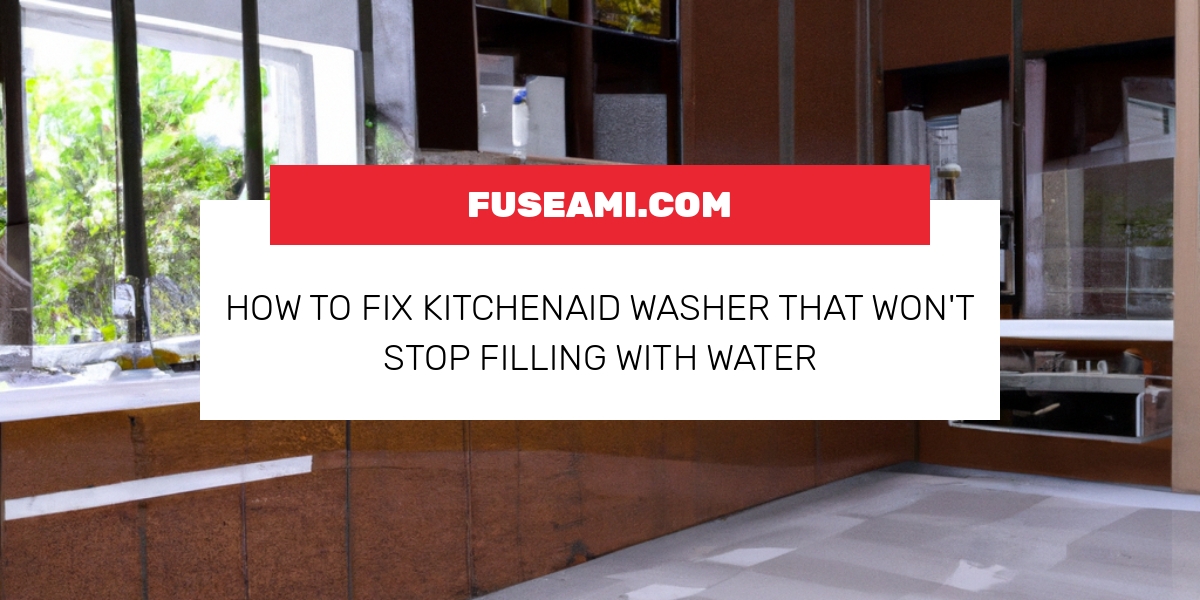If you’ve been facing an KitchenAid washing machine that doesn’t stop filling up with water, you know how frustrating it can be. In addition to wasting water and energy, it could also cause harm to your floors as well as your KitchenAid washer itself. In this article, we’ll take a look at some of the common causes of this issue and give step-by step instructions on fixing a KitchenAid washing machine that won’t stop filling with water. It’s possible to find all the info you need to solve the issue with your KitchenAid washer, no matter whether you’re a professional or novice. Keep reading if you are eager to repair your KitchenAid washer!
Water Inlet valve
The Water Inlet Valve located on your KitchenAid washing machine is used to fill the tub with hot, cold, or warm water to wash and rinse cycles. The valve is operated using electronic solenoids controlled by the electronic control board, or timer and the water level control switch, or pressure switch. If your KitchenAid washer continues to fill over the course of a cycle, the water inlet valve may be at fault. To check if the valve is at fault disconnect the KitchenAid washer once the issue is observed. If the KitchenAid washer continues to fill, then the valve to let water into the washer is not working properly. If the washer does not fill it is related to the circuit electrical that controls the valve. How to check the water inlet valve on a KitchenAid washing machine using a multimeter
- As with all other tests, ensure that you have turned off the power supply to the KitchenAid appliance prior to starting. You’ll be conducting electrical tests on the components.
- Locate and take out the valve for water intake. It’s located behind the hose connections. To access it, you’ll need the rear panel to be removed.
- Examine the valve visually for signs of damage or wear. It is necessary to replace the whole valve if it has screens.
- Utilizing a multimeter on Rx1 then, connect the probes to the terminals of the valve. You should receive a different reading for each model. Consult your manual to learn what reading you should be getting.
- You’ll require a replacement KitchenAid water inlet valve when the valve is damaged or your tests aren’t in line with the guidelines.
Water Level Switch and Pressure Switch and Air Dome Tube
The water level switch is a switch that activates by pressure which is used to determine the right level of water within the tub. This part is normally located in the back of the control panel. It will be fitted with a hose or an air dome tube that connects it with the tub. The switch is located beneath the tub in KitchenAid washers and comes with an electronic control. As the water fills in the tub, it will compress the air inside the tube and push against a diaphragm inside the switch. The valve that opens the water is operated by the switch, which will shut off the valve when it reaches the right water level. If the tube has a leak or is plugged in, not enough pressure could be created to activate the switch and the washer could overfill. If the switch is not working properly, it can cause the machine to fill too high. How do you check the water level switch inside theKitchenAid washing machine
- You’ll be working with electrical components, so be sure you disconnect the washer from power prior to starting.
- You must open your KitchenAid cabinet for your washer to locate and remove the water level switch and the air dome tube. After the air dome tube has been removed, put one end of it in the water tank and then blow the other end into the tank. Undamaged hoses will not produce bubbles.
- Inspect the valve and hose for cracks, wear or damage. If you find any problems in the previous inspections it is possible that you require KitchenAid replacement Water Level Switch.
In the end, a KitchenAid washing machine that doesn’t stop filling with water can be an aggravating and costly trouble to solve. By understanding the causes that are most likely to cause this issue and taking proper steps to correct it, you’ll reduce your time and expense. This article will assist you to repair the problem with your KitchenAid washer, regardless whether the issue is with the water level switch or the valve for inlet. It’s always a good idea to read your washer’s owner guide for specific troubleshooting tips and safety tips prior to making any repairs. If you’re not certain if your issue can be solved on your own, it’s recommended to call a professional to do repairs. Overall, with a some knowledge and the right approach, you can fix an issue with a KitchenAid washer that’s not refilling and you can go back to washing your clothes with ease.



